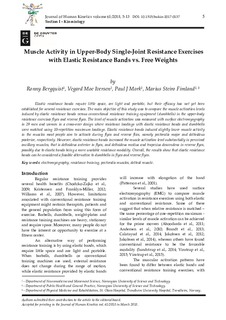| dc.contributor.author | Bergquist, Ronny | |
| dc.contributor.author | Iversen, Vegard Moe | |
| dc.contributor.author | Mork, Paul Jarle | |
| dc.contributor.author | Fimland, Marius Steiro | |
| dc.date.accessioned | 2019-02-18T14:08:58Z | |
| dc.date.available | 2019-02-18T14:08:58Z | |
| dc.date.created | 2017-11-22T15:37:42Z | |
| dc.date.issued | 2018 | |
| dc.identifier.citation | Journal of Human Kinetics. 2018, 61 (1), 5-13. | nb_NO |
| dc.identifier.issn | 1640-5544 | |
| dc.identifier.uri | http://hdl.handle.net/11250/2586025 | |
| dc.description.abstract | Elastic resistance bands require little space, are light and portable, but their efficacy has not yet been established for several resistance exercises. The main objective of this study was to compare the muscle activation levels induced by elastic resistance bands versus conventional resistance training equipment (dumbbells) in the upper-body resistance exercises flyes and reverse flyes. The level of muscle activation was measured with surface electromyography in 29 men and women in a cross-over design where resistance loadings with elastic resistance bands and dumbbells were matched using 10-repetition maximum loadings. Elastic resistance bands induced slightly lower muscle activity in the muscles most people aim to activate during flyes and reverse flies, namely pectoralis major and deltoideus posterior, respectively. However, elastic resistance bands increased the muscle activation level substantially in perceived ancillary muscles, that is deltoideus anterior in flyes, and deltoideus medius and trapezius descendens in reverse flyes, possibly due to elastic bands being a more unstable resistance modality. Overall, the results show that elastic resistance bands can be considered a feasible alternative to dumbbells in flyes and reverse flyes. | nb_NO |
| dc.language.iso | eng | nb_NO |
| dc.publisher | De Gruyter Open | nb_NO |
| dc.rights | Attribution-NonCommercial-NoDerivatives 4.0 Internasjonal | * |
| dc.rights.uri | http://creativecommons.org/licenses/by-nc-nd/4.0/deed.no | * |
| dc.title | Muscle Activity in Upper-Body Single-Joint Resistance Exercises with Elastic Resistance Bands vs. Free Weights | nb_NO |
| dc.type | Journal article | nb_NO |
| dc.type | Peer reviewed | nb_NO |
| dc.description.version | publishedVersion | nb_NO |
| dc.source.pagenumber | 5-13 | nb_NO |
| dc.source.volume | 61 | nb_NO |
| dc.source.journal | Journal of Human Kinetics | nb_NO |
| dc.source.issue | 1 | nb_NO |
| dc.identifier.doi | 10.1515/hukin-2017-0137 | |
| dc.identifier.cristin | 1517349 | |
| dc.description.localcode | This article has been published in Journal of Human Kinetics, https://doi.org/10.1515/hukin-2017-0137. This version is free to view and download for private research and study only. Not for re-distribution, re-sale or use in derivative works. © copyright holder | nb_NO |
| cristin.unitcode | 194,65,30,0 | |
| cristin.unitcode | 194,65,20,0 | |
| cristin.unitname | Institutt for nevromedisin og bevegelsesvitenskap | |
| cristin.unitname | Institutt for samfunnsmedisin og sykepleie | |
| cristin.ispublished | true | |
| cristin.fulltext | original | |
| cristin.qualitycode | 1 | |

